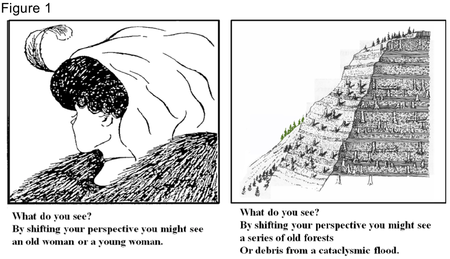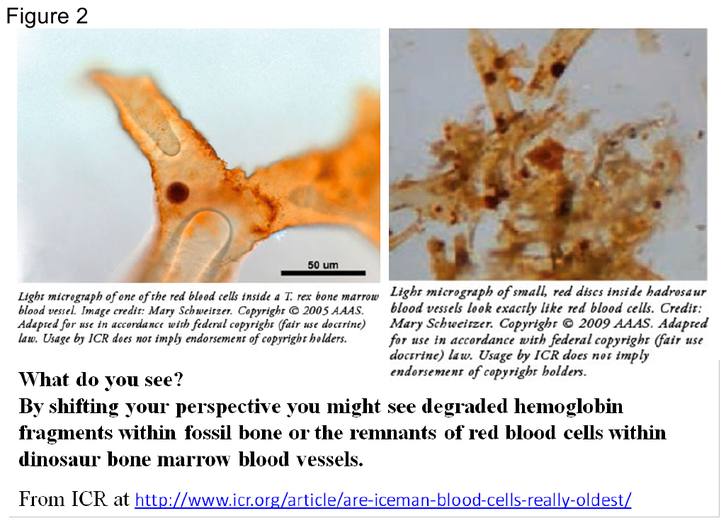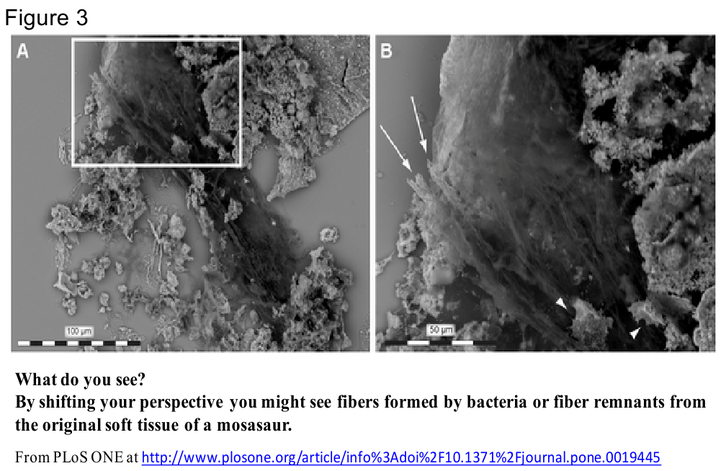Creation: A Matter of Perspective
What perspective should we have when we investigate one of God's greatest miracles, the creation of all living things?

Figure 1
Is it His nature to perform miracles in a way that could be confused with the natural order of things? Most of the accounts in scripture suggest otherwise. Jesus’ first recorded miracle was not to ferment grape juice into wine, but to create wine from water. His miracles were big, extraordinary events. He did not feed the five; He fed the 5,000. He did not raise Lazarus from the “mostly dead;” he purposefully waited four days so people would know beyond a shadow of a doubt that He raised him from the “clearly dead.” He did not rise from an unguarded and open tomb, but from a well guarded tomb that was blocked by a large stone.
God is not the author of confusion (1: Corinthians 14:33). He intentionally performs miracles that are unmistakably and undeniably His. In this article, I’d like to briefly examine some scriptural evidence and then summarize some recent fossil finds which suggest that, consistent with the nature of God, creation was not natural.
Scripture
What’s in a day? We really only need one verse from Genesis 1 to demonstrate that God’s intention was not to have creation understood as a slow and gradual, unremarkable process. Take Genesis 1:5: “And God called the light Day, and the darkness he called Night. And the evening and the morning were the first day.” There’s not much more you could do to make it clear that this passage is speaking of a literal day, and the same text is repeated for all seven days of the creation account. Yes, the Hebrew word yom used here for “day” does not always have to mean a literal day. However, yom is modified by a number as it is here 359 times in Scripture, and each time the word always means a literal day. Outside of Genesis 1, ”evening” and “morning” appear together 38 times and one or the other appear with yom 23 times, a total of 61 times, each referring to an ordinary day. 1 There is no reason for an exception in the case of God’s unmistakable creation miracle.
What did Jesus say? In reference to divorce, Jesus reminded the Pharisees that “at the beginning of creation God ‘made them male and female’” (Matthew 19:4; Mark 10:6). It seems fairly clear that Jesus was affirming the Genesis account of God creating man and wife in a day, ex nihilo (out of nothing).
What is the basis of our seven-day week? All the other important time markers in human life are based on astronomical and terrestrial constants. The day is the duration of one rotation of the earth on its axis; the year is the duration of one orbital revolution of the earth about the sun; the month is the approximate interval between new moons; the seasons are marked by the equinoxes and solstices. But the week has no astronomical basis whatever! Yet we order our lives in a seven-day cycle, including six normal days and a day of rest. The only cause which is able to account for such a remarkable phenomenon as the week is that it was established at creation and has been deeply etched in the common human consciousness ever since. 2 “For in six days the Lord made heaven and earth, the sea, and all that in them is, and rested the seventh day: wherefore the Lord blessed the Sabbath Day, and hallowed it” (Exodus 20:11).
The Importance of Perspective Regarding the Fossil Record
Since most of us have been taught the old fossil perspective from an early age by secular scientists and teachers who stake their livelihood on or are required to profess naturalistic theories, it is not always easy to see the young fossil perspective. Take for example the two artistic renderings in Figure 1.
Until I knew to look for the ear and the necklace in the drawing on the left, I could not see the young perspective. The drawing on the right is a cutaway view of petrified trees in an area of Yellowstone National Park called Specimen Ridge. For many years, scientists could only see a series of old forests that grew on top of one another over tens of thousands of years. This had dire consequences for Ron Numbers, who wrote in the preface of his book on creationist history that he “slid down the proverbial slippery slope towards unbelief” after he attended a lecture about this “famous sequence of fossil forests” and spent that night “agonizing over, then finally accepting , the disturbing likelihood that the earth was at least thirty thousand years old.” 3 Since his experience, the sign depicting the “sequence of forests” story has been removed from the park. Scientific research into how trees were sheared off and deposited into nearby Spirit Lake after the 1980 Mount St. Helens eruption have convinced even secular scientists that the petrified trees at Yellowstone (which were also sheared at their base) were deposited following a similar catastrophic event. 4
The Importance of Time and the Fossil Record
While it is difficult to imagine how life could have spontaneously generated itself, regardless of the time allotted, without hundreds of millions of years, evolution is unquestionably impossible and creation is the only alternative. This is why evidence that fossils are not even millions of years old is so enticing to young-earth creationists and vexing to (or ignored by) evolutionists.
The Creation Ministries International (CMI) website contains a recent and extensive listing of “101 evidences for a young age of the earth and the universe. 5 The one method most often cited by evolutionists as indicating old ages is radiometric dating. Because of the way radiometric dating works, only rocks of volcanic origin can yield ages in excess of 100,000 years. Dr. David Plaisted and others have documented numerous examples where radiometric dating methods are unable to produce the correct date in cases where the actual date of eruption is known. 6 The recently completed, multimillion dollar Institute for Creation Research (ICR) Radioisotopes and the Age of the Earth (RATE) project has extensively documented that radioactive dating methods and their results are not thorough, consistent, or reliable. 7
In 2009, I wrote an article discussing the findings of soft tissue and remnants of red blood cells, including hemoglobin, in Tyrranasaurus rex and hadrosaur bones alleged to be tens of millions of years old (Figure 2). 8

Figure 2
That evidence seems to have been overlooked when red blood cells discovered in the famous 5300 year old “iceman” fossil 9 were reported to be “the world’s oldest blood cells.” 10
Over the past three years, ICR has documented at least 20 cases of original soft tissues found in fossilized remains around the world, including a recent report that contents of ink found in a “160 million year old” squid fossil has not degraded and is chemically similar to the ink found in modern cuttlefish. 11 ,12
These are just the examples gathered by one ICR scientist. Many more examples must exist. Below, I will briefly review an extraordinary report of carbon-14 and soft tissue found in a “70 million year old” 10-foot long mosasaur (extinct marine reptile) fossil. But first, a review of the carbon-14 dating method might be helpful.
Carbon-14
The most well-known of all the radiometric dating methods is radiocarbon (carbon-14) dating. It is limited to dating things that contain carbon and were once alive, and can yield dates of only thousands of years because of its half-life. The Answers in Genesis website contains a relatively recent and complete description of the carbon-14 dating method at answersingenesis.org/articles/am/v5/n4/ carbon-dating. For now, you just need to know that
- (1) carbon-14 is constantly forming in the atmosphere when subatomic particles created by cosmic rays collide with nitrogen-14,
- (2) carbon-14 is unstable and decays back to nitrogen-14,
- (3) living plants and animals maintain a constant carbon-14 level in them (while alive, they replace any carbon molecule that has decayed into nitrogen), and
- (4) once they die they no longer take in carbon and the carbon-14 in them decays with a half-life of 5,730 years (i.e., half of the carbon-14 in the dead animal or plant will decay every 5,730 years).
Assuming the plant or animal had the same number of carbon-14 atoms in it as living plants and animals today (estimated at one unstable carbon-14 atom for every trillion stable carbon-12 atoms), Table 1 shows what the ratio of carbon-12 to carbon-14 should be in the dead (fossil) plant or animal after as many as five half lives (28,650 years).
| Amount of stable C-12 | Amount of unstable C-14 | Ratio | Years Dead | # Half-lives |
|---|---|---|---|---|
| 100 Trillion | 100 | 1-T to 1 | 0 | 0 |
| 100 Trillion | 50 | 2-T to 1 | 5,730 | 1 |
| 100 Trillion | 25 | 4-T to 1 | 11,460 | 2 |
| 100 Trillion | 12.5 | 8-T to 1 | 17,190 | 3 |
| 100 Trillion | 6 | 16-T to 1 | 22,920 | 4 |
| 100 Trillion | 3 | 32-T to 1 | 28,650 | 5 |
Today’s instruments can detect radiocarbon at levels below 1 carbon-14 atom per 100 trillion carbon-12 atoms. Measurable amounts of carbon-14 have been found throughout the geological column indicating rock ages from 30,000 to 50,000 years. 13 The Answers in Genesis article referred to above reviews these findings and offers several reasons why these carbon-14 dates could be overestimates, including the reduction in carbon-12 due to massive burial of vegetation during the Flood.
Carbon-14 and Soft Tissue Fibers in a “70 Million Year Old” Fossil
Although the assumption that carbon-14 could not possibly be present in fossils generally prevents carbon dating being attempted (e.g., no dating had been attempted on the T. rex or Hadrosaur samples), one group of researchers has obtained a carbon date of 24,600 years from a soft tissue sample of a 10-foot long mosasaur fossil that is alleged to be 70 million years old. 14 Using five different tests, they showed that soft tissue fibers in the fossil (Figure 3) were most likely original mosasaur tissue containing fibrous structural proteins, such as collagen, and were not formed by bacteria. However, despite this and the fact that “no bacterial proteins or hopanoids [cholesterol-like compounds] were detected,” they speculate that the surprisingly high level of carbon-14 detected in the sample was from bacterial contamination. As evidence, they state that “one bacterial DNA sequence was amplified by PCR, and microscopic clusters of bone-boring cyanobacteria were seen in places along the perimeter of the diaphyseal cortex” but provide no further clarification as to how the DNA was determined to be of bacterial origin and whether there was enough “microscopic” bacteria to explain the high carbon-14 readings. This appears to be another matter of perspective for given their own evidence for a lack of bacterial contamination and the following evidence (some might say common knowledge) that soft tissue would not last tens of millions of years, there seems to be ample reason to suggest that the mosasaur tissue and bone itself was responsible for the high carbon-14 levels.

Figure 3
How Long Can Collagen and Complex Proteins Last?
Collagen and elastin proteins that have been found in the mosasaur and other dinosaur fossils 3 are part of a mixture of biological materials contained in soft tissue, such as cartilage, that is integral to bone tissue. Internal hydrolysis [the breaking of a molecule involving the splitting of water molecules] effectively fragments these proteins within the tissue, so that it spontaneously falls apart. 15 In the absence of a catalyst, the half-life for the hydrolysis of a typical peptide [short protein segment] at neutral pH is estimated to be between 10 and 1000 years. 16 Collagen locked in bone should not be older than 30,000 years, and collagen in cartilage would decay faster than that inside the mineralized bone matrix since it is much more exposed. 15
His Eternal Power and Divine Nature
The Bible, through Peter (2 Peter 3:3-6), predicts that we would one day forget the unmistakable acts of God, including Creation and the Flood. When we forget these unmistakable events, we run the risk of falling prey, like Ron Numbers, to alternative explanations that do not involve God. Yet, things like the deposition of tree stumps in Spirit Lake and the formation of amazingly Grand Canyon-like rock formations following the eruption of Mount St. Helens have shown us the power of catastrophic events versus slow and gradual processes. And now evidence that fossils are not millions of years old is mounting, and we could be on the verge of a cataclysmic paradigm shift in our scientific community. For since the creation of the world God’s invisible qualities—His eternal power and divine nature—have been clearly seen, being understood from what has been made, so that people are without excuse (Romans 1:20). But in order to see creation in a way that truly reveals “His eternal power and divine nature” most scientists will need to experience a 180° change in perspective. Ô
- 1Stambaugh J (1991) The days of creation: A semantic approach. TJ 5(1):70–78. Available at http://www.answersingenesis.org/articles/tj/v5/n1/semantic Accessed 2012 Jul 21
- 2Bauer WJ Creation and the seven-day week. http://www.icr.org/article/157 Accessed 2012 Jul 21
- 3 a b Numbers R (1992) The Creationists: The Evolution of Scientific Creationism. University of California Press, Berkeley and Los Angeles, CA
- 4Sarfati J The Yellowstone petrified forests: Evidence of catastrophe. http://creation.com/the-yellowstone-petrified-forests Accessed 2012 Jul 21
- 5Batten D (2009) Age of the earth: 101 evidences for a young age of the earth and the universe. http://creation.com/age-of-the-earth Accessed 2012 Jul 21
- 6Plaisted D (1998) The radiometric dating game. http://www.trueorigin.org/dating.asp Accessed 2012 Jul 21
- 7Vardiman L, Snelling AA, Chaffin EF (2005) Radioisotopes and the Age of the Earth. Volume II. Institute for Creation Research, El Cajon, CA and Creation Research Society, Chino Valley AZ http://www.icr.org/rate2/ Accessed 2012 Jul 21
- 8Gift J (2009) Dinosaur bones: A whole lot of twistin’ goin’ on. TASC Newsletter. http://tasc-creationscience.org/content/dinosaur-bones-whole-lot-twistin-goin-0 Accessed 2012 Jul 21
- 9Janko M, Stark RW, Zink A (2012) Preservation of 5300 year old red blood cells in the Iceman. J R Soc Interface. http://rsif.royalsocietypublishing.org/content/early/2012/04/26/rsif.2012.0174 Accessed 2012 Jul 22
- 10Pappas, S. (2012) ‘Iceman’ mummy holds world’s oldest blood cells. http://www.livescience.com/20030-ice-mummy-oldest-blood-cells.html Accessed 2012 Jul 22
- 11Fresh Tissues Show That Fossils Are Recent http://www.icr.org/fresh-fossils/ Accessed 2012 Jul 21
- 12Glass K, Ito S, Wilby PR, Sota T, Nakamura A, Bowers CR, Vinther J, Dutta S, et al. (2012) Direct chemical evidence for eumelanin pigment from the Jurassic period. Proc Nat Acad Sci 109(26):10218-23.
- 13Baumgardner JR Humphreys R, Snelling A, Austin SA (2003) Measurable 14C in fossilized organic materials: Confirming the young earth creation-flood model. Proceedings of the Fifth International Conference on Creationism, Creation Science Fellowship, Pittsburgh, PA, 127-42
- 14Lindgren J, Uvdal P, Engdahl A, Lee AH, Alwmark C, Bergquist K-E, Nilsson E, Ekström, et al. (2011) Microspectroscopic evidence of cretaceous bone proteins. PLoS ONE 6(4):e19445
- 15 a b Bada JL, Wang SX, and Hamilton H (1999) Preservation of key biomolecules in the fossil record: Current knowledge and future challenges. Philos Trans R Soc Lond B Biol Sci 354(1379):77-87
- 16Berg JM, Tymoczko JL, Stryer L (2002) Proteases: Facilitating a difficult reaction. Biochemistry, 5th ed. W. H. Freeman, New York, NY